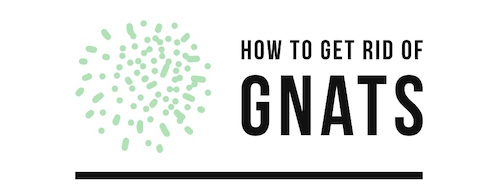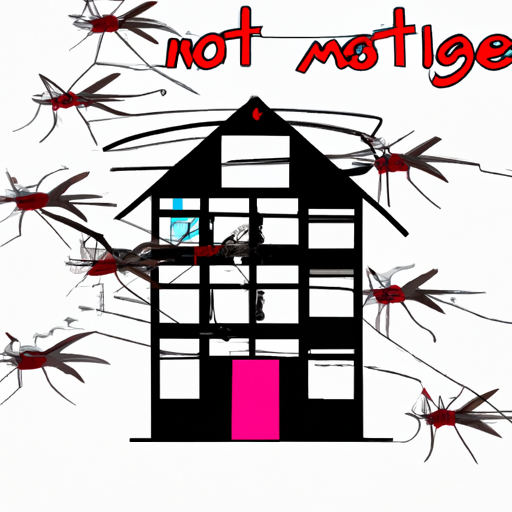How to Identify a House Gnat Infestation
House gnats, also known as fungus gnats, are small flying insects that can become a nuisance in the home. They are attracted to moist areas and feed on decaying organic matter such as plant roots and fungi. A house gnat infestation can be identified by the presence of adult gnats flying around windows or lights, larvae in soil or other damp areas, and webs of silk near the base of plants.
To identify a house gnat infestation, look for adult flies hovering around windows or lights. These adults may be black or gray in color with long legs and antennae. They typically measure about 1/8 inch long and have transparent wings with dark veins running through them. Additionally, you may notice larvae crawling around damp areas such as soil or mulch piles outside your home. These larvae are usually white to yellowish-white in color with black heads and measure up to 1/4 inch long when fully grown. Finally, you may find webs of silk near the base of plants which is an indication that house gnats have laid eggs there.
If you suspect a house gnat infestation in your home it is important to take action quickly before they spread further throughout your living space. To get rid of them you should first reduce moisture levels by fixing any leaks or drainage problems that could be attracting them into your home; then remove any decaying organic matter from inside and outside your property; finally use insecticides specifically designed for fungus gnats to kill both adults and larvae before they can reproduce further generations of these pests
Natural Ways to Get Rid of House Gnats
House gnats are a common nuisance in many homes. These small, flying insects can be difficult to get rid of and may require multiple treatments. Fortunately, there are several natural methods that can help you eliminate house gnats from your home.
One of the most effective ways to get rid of house gnats is to use sticky traps. These traps contain a sticky substance that will trap the gnats when they come into contact with it. Place these traps near areas where you have seen the most activity from the gnats, such as near windows or doors.
Another natural way to get rid of house gnats is by using vinegar and dish soap solutions. Mix equal parts white vinegar and dish soap in a spray bottle and spray it around areas where you have seen the most activity from the gnats. The solution will kill any adult flies on contact while also deterring new ones from entering your home.
You can also use essential oils such as peppermint oil or eucalyptus oil to repel house gnats naturally. Simply mix 10-15 drops of essential oil with one cup of water in a spray bottle and spray it around areas where you have seen activity from the pests, such as windowsills or door frames. The strong scent will repel them away without harming them or your family members in any way.
Finally, make sure that all food sources are properly sealed so that they do not attract more house flies into your home environment; this includes pet food bowls as well as open containers of fruits and vegetables stored in pantries or refrigerators/freezers . Additionally, keep all surfaces clean by wiping down counters regularly with an all-purpose cleaner; this will help reduce their breeding grounds within your home environment .
The Dangers of Having House Gnats in Your Home
House gnats are small, flying insects that can be found in homes across the country. While they may seem harmless, these pests can cause a variety of problems for homeowners. Here are some of the dangers associated with having house gnats in your home.
First, house gnats can spread disease and bacteria. These pests feed on decaying organic matter and human food waste, which often contains harmful bacteria and viruses. As they move from one food source to another, they can spread these pathogens throughout your home. This increases the risk of illness for you and your family members.
Second, house gnats can damage furniture and other items in your home. They lay their eggs on surfaces such as wood or fabric, which causes them to become stained or discolored over time. In addition, their larvae feed on organic materials like wood or fabric fibers which can weaken them over time leading to structural damage if left unchecked for too long.
Finally, house gnats are a nuisance that no one wants to deal with in their home! They fly around erratically making it difficult to concentrate or relax while inside your own home due to their constant buzzing sound and presence alone!
In conclusion, having house gnats in your home is not something you want to take lightly as it poses several risks including spreading disease-causing bacteria/viruses; damaging furniture/other items; and being an annoying nuisance all around! If you suspect you have an infestation of these pests it is important that you contact a professional pest control service right away so they can help eliminate the problem before it gets worse!
Common Causes of House Gnat Infestations
House gnats, also known as fungus gnats, are small flying insects that can become a nuisance in homes. They are attracted to moist areas and feed on decaying organic matter such as fungi, plant roots, and other decaying organic material. Gnat infestations can be difficult to control because they reproduce quickly and can spread throughout the home.
Common causes of house gnat infestations include:
1. Overwatering plants: Houseplants often require regular watering but overwatering them can create an ideal environment for fungus gnats to breed in the soil.
2. Poor drainage: Poor drainage around the home or in flower beds creates standing water which is a perfect breeding ground for fungus gnats.
3. Compost piles: Compost piles provide an ideal environment for fungus gnats to breed and lay eggs if not managed properly or kept away from the home’s foundation walls or windowsills where they could enter the house easily.
4. Open garbage cans: Garbage cans that are left open or uncovered provide an ideal breeding ground for house gnats due to their moist contents and lack of air circulation which allows them to thrive without being disturbed by predators like birds or spiders that would normally eat them outdoors in nature.
5 . Unsealed food containers : Unsealed food containers left out on countertops attract fruit flies which then lay eggs that hatch into larvae which turn into adult house gnats if not removed quickly enough before they have a chance to mature into adults .
Prevention Tips for Keeping House Gnats Away
House gnats are small, annoying insects that can be difficult to get rid of. To keep them away, it is important to take preventive measures. Here are some tips for preventing house gnats:
1. Keep your home clean and free of food debris. Gnats feed on decaying organic matter, so make sure to regularly clean up any spills or crumbs in your kitchen and other areas of the house where food is present.
2. Empty garbage cans frequently and store them outside if possible. Garbage cans are a prime breeding ground for gnats, so make sure they’re emptied regularly and stored away from the house if possible.
3. Seal cracks or crevices around windows and doors with caulk or weatherstripping to prevent gnats from entering your home through these openings.
4. Use fans in areas where you’ve seen gnat activity as this will help reduce their numbers by blowing them away from the area they’re congregating in.
5 . Place yellow sticky traps near windowsills or other areas where you’ve seen gnat activity as this will help catch any adult flies before they can lay eggs which will hatch into larvae that become more adult flies later on down the line .
6 . Use natural insecticides such as neem oil or pyrethrin-based products which can be sprayed directly onto surfaces where you have seen evidence of gnat activity . These products are safe for use around humans but should still be used with caution when spraying near food items .

